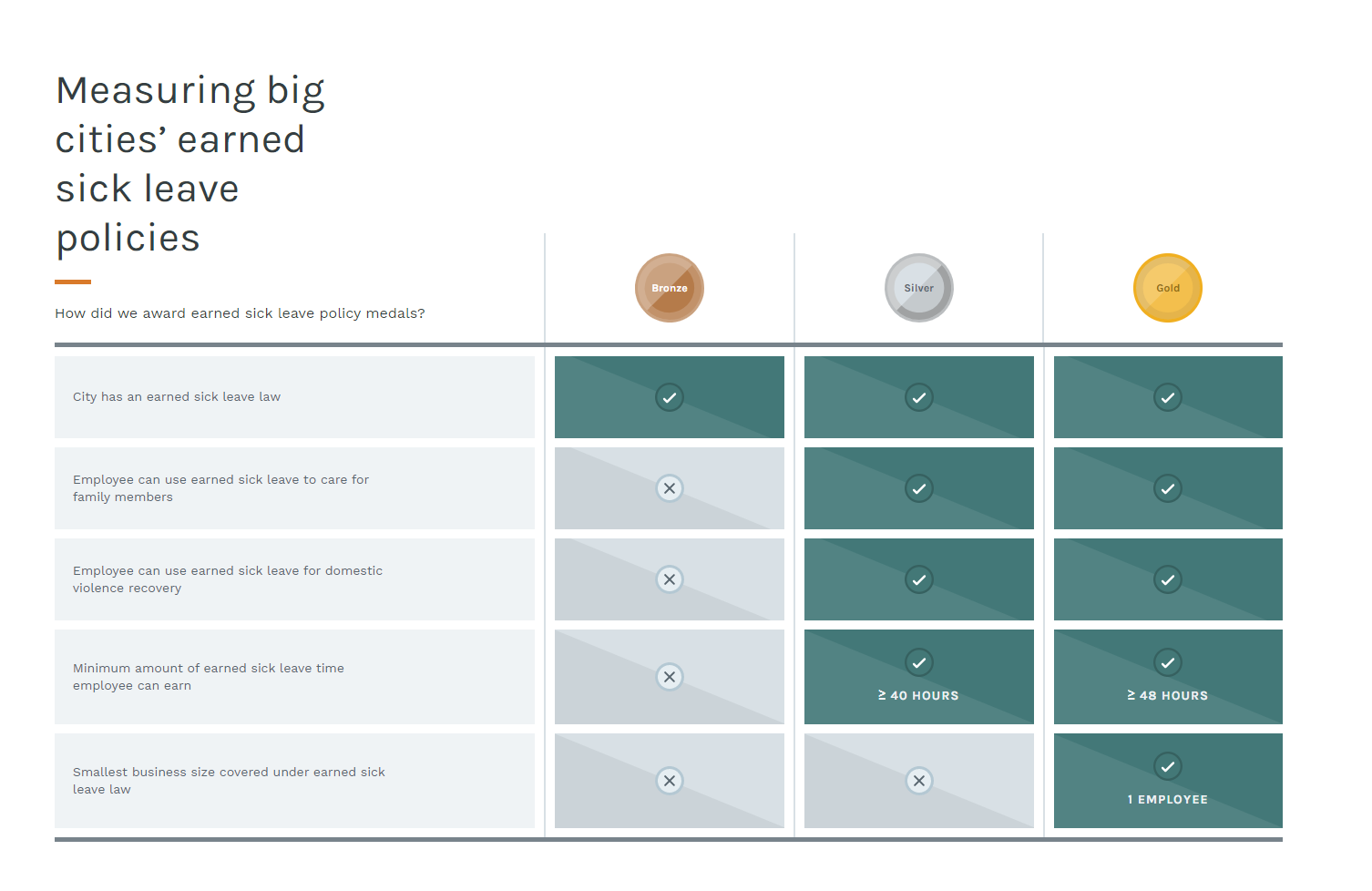
Share On Social!
Without paid sick leave, too many Latinos are forced to choose between financial security and health.
After all, just a few days of lost pay due to illness is the same as losing an entire month’s worth of groceries for some families, which fare worse during a pandemic like COVID-19.
“For a typical Latino family without paid sick days, losing an average of 3.3 days due to sickness is equivalent to a family’s entire monthly health care budget or its monthly grocery budget,” according to a joint fact sheet from UnidosUS and National Partnership for Women & Families.
This situation won’t just fix itself after the pandemic, either.
“Lives are at stake when policies are not put in place from the top down to prevent the spread of disease or create healthy living conditions,” said Shelley Hearne of CityHealth.
Why Focus on Policy Change During (And Beyond) a Pandemic?
America has a history of systemic discrimination in the pay and exploitation of workers based on race, class, gender, and immigration status. The nation also has a history of systemic disinvestment in the communities these workers live.
Cities with evidenced-based policies, like paid sick leave, affordable housing and complete streets, can ensure historically disadvantaged communities stay healthy and prosper.
Upstream policies that prevent health problems and protect financial security, like paid sick leave, are more effective to improve community health, than downstream efforts to care for untreated health problems and address social and economic problems.
1. Paid Sick Leave Policies Protect Latinos
More than half of Latinos are unable to earn a single paid sick day through their jobs, according to the Latinos and Their Families Need Paid Sick Days Fact Sheet from the National Partnership for Women & Families and Unidos US.
“Latinos have the highest labor force participation rate of any racial or ethnic group in the United States and are the fastest-growing segment of the workforce, yet they are the least likely to have access to paid sick days,” according to the fact sheet.
Staying home due to illness or health needs can have serious economic consequences for these families, jeopardizing employment stability and financial security.
Thus, many Latino workers have no choice but to go to work and risk their health or the health of coworkers, customers, and the public.
This is playing out in real time amid the coronavirus pandemic. And history backs it up. During the 2009 H1N1 pandemic, for example, an estimated 1.2 million additional cases of flu-like illness among Latinos can be attributed to lack of sick leave.
Moreover, 60% of Latina mothers are the breadwinners for their families. More than 20% of Latinos serve as caregivers to an adult family member or someone close to them.
Paid sick leave policies can help working Latinos prevent the spread of contagious diseases and get themselves, their children, and their loved ones to necessary checkups, immunizations, and preventative screenings.
2. Paid Sick Leave Policies Protect Lower-Income Populations
Lack of paid sick leave degrades employment and income stability. It also worsens health disparities, particularly for low-income populations are less likely to have paid sick leave.
Only one in two workers with the lowest wages have paid sick days to care for their own health, compared to more than nine in 10 workers with the highest wages.
A survey of food workers found that those without paid sick leave were 1.6 times more likely to go to work when they have a contagious illness than workers with paid sick leave.

Low-income workers without paid sick leave are the most likely to forego medical care. This putsthemselves and others at higher risk for chronic and infectious diseases.
However, we know that income isn’t distributed equally in America.
On average, Latinos are paid less and have less savings than White workers. Women consistently earn less than men at all income levels and are more likely to work in the lowest-paying jobs.
Latinas with a college degree, for example, are paid 35% less than white men with the same degree.
With lost income, comes lost opportunities to maintain health, like staying home when ill or when a child is ill.
These issues add up even more quickly for Latinos and women.
Earned sick leave policies protect workers in lower-wage jobs, workers facing inequities in pay, and their families.
Access to earned sick leave is associated with increased job stability and the likelihood that low income parents take leave when their children have health problems.
When Seattle required earned sick leave for all workers, the biggest increases in coverage were for part-time and lower-income workers, particularly those working in the hospitality industry, like food service, according to CityHealth.
3. Paid Sick Leave Policies Improve Worker Productivity
Productivity declines when workers are out sick. This is known as absenteeism.
Providing earned sick leave could save employers as much as $1.88 billion per year in absenteeism costs from flulike illnesses, according to CityHealth.
Productivity also declines when workers come to work while sick, known as “presenteeism.”
Presenteeism is estimated to cost our national economy $160 billion annually.
Allowing people to take off when they are sick reduces the risk of spreading contagious disease within a workplace, thus preventing an outbreak and further decline in worker productivity.
4. Businesses Support Paid Sick Leave Policies
A year and a half after implementation of Connecticut’s earned sick days law, three-quarters of surveyed employers expressed support for the policy, and most reported a modest impact or no impact to their costs and business operations, according to CityHealth.
In Seattle, s survey found that 70% of business owners favored the city’s earned sick days law one year after it was implemented.
5. Paid Sick Leave Policies are Good for Cities
Workers without paid sick days are less likely to go to the doctor or access preventive care.
Access to paid sick leave is associated with greater use of physician services, like preventive screenings, and reduced reliance on emergency room visits for untreated health problems.
Access to paid sick days reduces flu infections in the workplace by nearly 6%.
This saves cities money.
Moreover, paid sick leave increases employment and income stability, which is important for economic growth.
If paid sick leave is implemented nationally, it would reduce emergency room visits by an estimated $1.3 million, saving an estimated $1.1 billion in medical a year, according to the Institute for Women’s Policy Research.
Currently, only 17 cities, three counties, and 11 states have paid sick day laws.
Unfortunately, due to preemption laws, cities are blocked from enacting paid sick leave policies in some states, like Texas.
Austin, Dallas, and San Antonio, for example, are unable to enforce the paid sick leave policies passed in each city due to legal challenges.
6. Only 5 of 40 Cities Earned Gold for Paid Sick Leave Policies
CityHealth, an initiative of the de Beaumont Foundation and Kaiser Permanente, evaluates the nation’s 40 largest cities on nine evidence-based policies, including paid sick leave.
Policies were selected that met specific criteria of being largely under city jurisdiction, being backed by evidence, and showing a track record of bipartisan support.
In the early days of COVID-19, it was clear how important paid sick leave policies would be.
Unfortunately, CityHealth found that only five out of the 40 cities earned a gold medal for paid sick leave policies and only six earned silver.
 After COVID-19, providing and expanding access to paid sick leave policies is critical to equitably restart the economy, particularly for Latinos in the most populous cities.
After COVID-19, providing and expanding access to paid sick leave policies is critical to equitably restart the economy, particularly for Latinos in the most populous cities.
“Studies have shown that in cities and states that have implemented earned sick days, business owners are supportive of the policy and report that the costs are nonexistent or minimal,” according to CityHealth’s data.
7. Families First Coronavirus Response Act is Temporary and Excludes Many Workers
Although the Families First Coronavirus Response Act requires employers with fewer than 500 employees to provide paid sick leave to all employees, it is temporary and there are many exceptions.
Economists say somewhere between 6.8 million and 19.6 million workers could be left out of the coronavirus relief law.
That’s why groups like UnidosUS and the National Partnership for Women & Families will keep pushing legislators for paid leave, and CityHealth will continue to evaluate cities’ paid sick leave policies after the COVID-19 pandemic.
The Healthy Families Act, for example, introduced in Congress in March 2019, would allow workers at businesses with 15 or more employees to earn up to seven job protected paid sick days each year to be used to recover from their own illnesses, access preventive care, provide care to a sick family member, or attend school meetings related to a child’s health condition or disability
“5.2 million Latinos would benefit from the healthy Families Act, including 2.7 million Latinas,” according to a joint fact sheet from UnidosUS and National Partnership for Women & Families.
Share this with social justice, public health, and political leaders in your community.
It is also important to push for paid family leave, which is linked to reduced infant mortality, increased rates of breastfeeding, and improved child and family health and well-being overall.
“As our nation faces an outbreak around coronavirus, it is past time for a national paid sick days standard that would protect the well-being of Latinos and all working families,” according to the Latinos and Their Families Need Paid Sick Days Fact Sheet.
By The Numbers
142
Percent
Expected rise in Latino cancer cases in coming years



